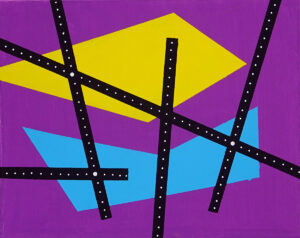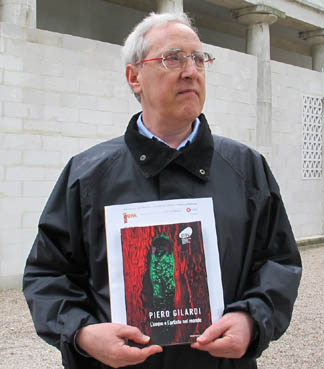Nino Barone lives in Termoli, where he was born in 1955. He has a degree in Architecture. In 1975 he founded the “Gruppo Solare”, of which he was a part until 1998; he also contributed to the birth of the “Gruppo di Orientamento” and the “Archetyp’Art” International Movement. From 2005 to 2014 he conceived and coordinated “Tracker Art”, the Conference of the New Criticism of Italian Art. From 2007 to 2014 he managed the “Officina Solare” Contemporary Art Gallery in Termoli. In 2008, he participated in the LIII Premio Termoli and he awarded the first prize. He has participated in more than one hundred exhibitions and his works appear in galleries and private collections in Italy and abroad.
What are you doing in Termoli?
Since I started painting (about forty-two years ago) I have been committed to moving the artistic and cultural environment of my city, with the constant aim of disseminating the sixty-year experience of Premio Termoli. Unfortunately, this event (which also involved some of the most important and significant artists on the Italian and international scene) did not succeed in making the city and regional cultural fabric grow.
Would you have any idea to make this city more “modern”?
Termoli is a beautiful seaside city where you live well for its climate and natural beauty, but it lacks all those public structures of social involvement that give it the dimension of a city. It seems strange but there is only one parish cinema, there is no longer a theater, not an Auditorium or a museum that can collect the artifacts and its history of about sixteen hundred years, a municipal library worthy of the name enhanced with new multimedia technologies; not even thought of characterizing the large Municipal Park with games and sculptures of the characters of Benito Jacovitti, for example.
Can you tell us something about Italy?
I think that the reflection I have made for my city may also be largely valid for the rest of our country: all the political administrations and bodies responsible for the enhancement of the national artistic heritage are concentrated only on the management of what the past has given us, keeping all the experiences of today’s immaterial culture out of the social circuit and isolating artists and works that do not fall within the parameters of the globalization market.
Can you give a frame of reference to your pictorial world?
I feel to place myself in the wake of conceptual artists who make art through the interrelationships expressed with a “logical calculation”, different from simple representation. My signs follow the order of logical structures. The memory of signs is the strength of a wave-corpuscle that builds relationships in an environment. My cognitive “game” consists in superimposing the other code on a primordial and energetic sign language, which makes use of the traditional indices of representation. I am referring to the choice of building topographic relationships through a code of forces, directions and intensity of frequencies.
So, which authors do you perceive as realated?
For concepts and creative purposes I really appreciate the work of Sol LeWit and Peter Halley as they have fully managed to relate the interior space of creative influence with a new conception of external space.
In your work we find the suggestion of microbial lives, of neuronal intertwining…
In my paintings I try to introduce a linguistic code consisting of indicator elements such as the path, the junction, the bifurcation, the intersection and the interruption of direction. These indicators are organized according to the emergence of the forms of action attributed to energy shifts and have the value of “space-time arrows”. “La freccia ferma: tre tentativi di annullare il tempo” written by Elio Fachinelli (Adelphi Edizioni) is one of my meditation points. My artistic universe is composed of signs, or strokes, and irregular shapes that recall the visual experience of microbial lives hidden in the unconscious that rematerialize not only for this representative system but also through visual stimuli that I construct in order to make them react actively perception of the viewer. A simple way to actively involve the viewer in the conceptual construction of the painting.
You have just completed a solo show in Arezzo…
This is an exhibition that has aroused a lot of interest not only for the pictorial language but also for the theme I have dealt with. My storytelling Beyond the sign, beyond the color tells through images the issues on social inequalities that permeate the contemporary consumer society. It is a look beyond mass communication which has the defect of the banal spectacle of misery and death in the world; a vision that with realistic optimism goes beyond the usual and participates in the ongoing debate on the condition of contemporary humanity. Briefly, a look “beyond the hedge”, an artistic gesture that deals with the evidence of the facts and measures the effectiveness of Italian and world policies that are not aimed at rebalancing social and environmental problems.
You also participate in Paratissima Art Station (Turin, from 23 October to 8 December): how many works do you plan to exhibit?
My participation in this important event, an alternative to those of the global market, excites me a lot and I intend to exhibit five works that recall the theme of my solo exhibition at Villicana d’Annibale.
 Nino Barone, Superficie CCG + 5 Seg, 2020. Duco e acrilico su tela, cm 40 x 50, ph courtesy AdFormandum, Gorizia / Trieste
Nino Barone, Superficie CCG + 5 Seg, 2020. Duco e acrilico su tela, cm 40 x 50, ph courtesy AdFormandum, Gorizia / Trieste
 Nino Barone, Superficie GVR + 5 Seg, 2020. Duco e acrilico su tela, cm 50 x 40, ph courtesy Sinegraf
Nino Barone, Superficie GVR + 5 Seg, 2020. Duco e acrilico su tela, cm 50 x 40, ph courtesy Sinegraf
 Nino Barone, Superficie VGC + 5 Seg, 2020. Duco e acrilico su tela, cm 40 x 50
Nino Barone, Superficie VGC + 5 Seg, 2020. Duco e acrilico su tela, cm 40 x 50

He is editorial director of Juliet art magazine.






NO COMMENT